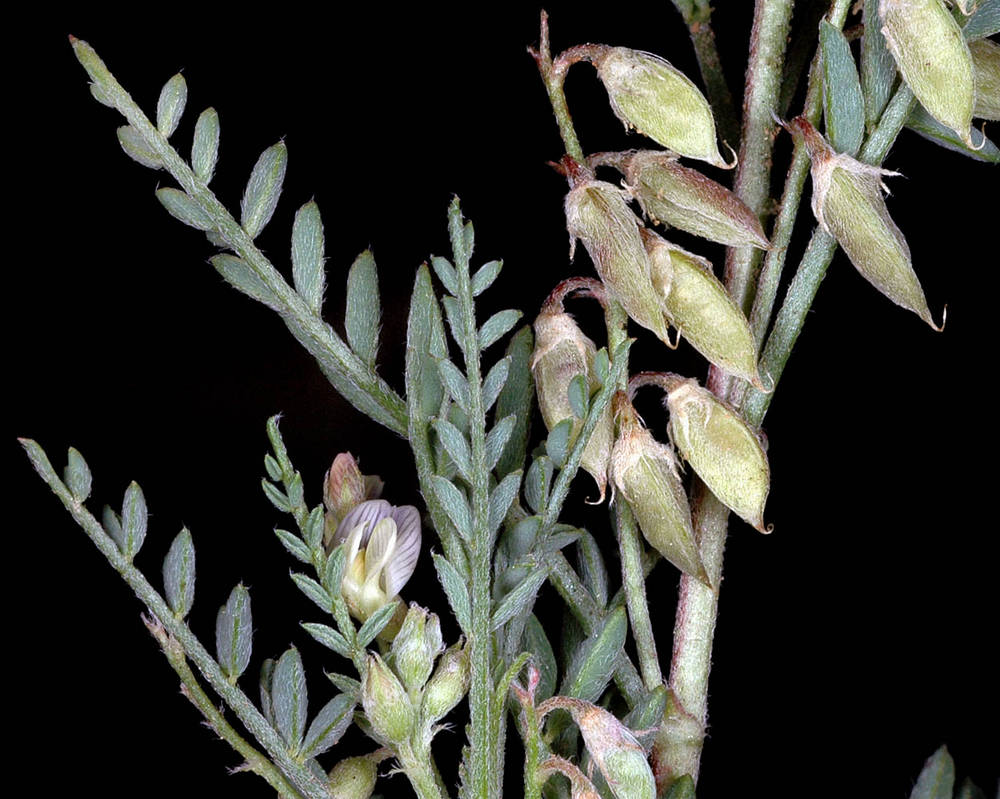|
|
Peck's milkvetch
|
|
Plants perennial, caulescent, with a thatch of stiff persistent petioles, grayish strigose-pilosulose, hairs basifixed. |
|
several–numerous; erect when young, prostrate with age; (1)5–20 cm. |
|
1–4 cm; leaflets 6–14, lanceolate, oblanceolate or linear-elliptic, 1–6 × 0.5–2 mm; tips acute or subacute; surfaces abaxially pubescent, adaxially pubescent or glabrescent; terminal leaflet confluent with rachis, filiform or slightly expanded, sometimes as recurved hook; stipules 1–3 mm, connate-sheathing. |
|
racemes loosely 5–9-flowered; peduncles 0.7–2 cm; bracts 1–1.5 mm; pedicels 1–2.5 mm; bracteoles 0. |
|
declined at anthesis; calyces 3.3–4.4 mm, densely strigillose with white hairs; tubes 1.8–2.1 mm; teeth subulate, 1.4–2.4 mm; corollas 5–7.5 mm, ochroleucous; banners purple-veined; ovules 7–9. |
|
bilocular, deflexed, oblong-ellipsoid; ovate-elliptic to lenticular, compressed triquetrous, 5–8 × 1.9–3.3 mm, strigose to villosulous; valves papery; stipes 0–0.5 mm. |
|
|
Astragalus pauperculus |
|
|
|
|
|
Pumice and sandy soils, sagebrush. Flowering May–Aug. 900–1500 m. Casc, ECas, Lava. Native. Endemic to Oregon. This endemic species is notable for its small, purple-veined flowers; small, compressed triquetrous fruits; prominent connate stipules; and thatch of persistent petioles. |
|
Flora of Oregon, volume 2, page 671
Richard Halse |
A. accidens, A. agrestis, A. alpinus, A. alvordensis, A. applegatei, A. arthuri, A. atratus, A. australis, A. beckwithii, A. californicus, A. calycosus, A. canadensis, A. caricinus, A. collinus, A. conjunctus, A. curvicarpus, A. cusickii, A. diaphanus, A. drummondii, A. eremiticus, A. filipes, A. gambellianus, A. geyeri, A. hoodianus, A. howellii, A. inflexus, A. iodanthus, A. kentrophyta, A. lemmonii, A. lentiginosus, A. malacus, A. misellus, A. mulfordiae, A. multiflorus, A. newberryi, A. nudisiliquus, A. obscurus, A. peckii, A. platytropis, A. purshii, A. reventus, A. robbinsii, A. salmonis, A. sclerocarpus, A. sheldonii, A. solitarius, A. spaldingii, A. sterilis, A. succumbens, A. tegetarioides, A. tetrapterus, A. toanus, A. tweedyi, A. tyghensis, A. umbraticus, A. vallaris, A. whitneyi |
A. accidens, A. agrestis, A. alpinus, A. alvordensis, A. applegatei, A. arthuri, A. atratus, A. australis, A. beckwithii, A. californicus, A. calycosus, A. canadensis, A. caricinus, A. collinus, A. conjunctus, A. curvicarpus, A. cusickii, A. diaphanus, A. drummondii, A. eremiticus, A. filipes, A. gambellianus, A. geyeri, A. hoodianus, A. howellii, A. inflexus, A. iodanthus, A. kentrophyta, A. lemmonii, A. lentiginosus, A. malacus, A. misellus, A. mulfordiae, A. multiflorus, A. newberryi, A. nudisiliquus, A. obscurus, A. peckii, A. platytropis, A. purshii, A. reventus, A. robbinsii, A. salmonis, A. sclerocarpus, A. sheldonii, A. solitarius, A. spaldingii, A. sterilis, A. succumbens, A. tegetarioides, A. tetrapterus, A. toanus, A. tweedyi, A. tyghensis, A. umbraticus, A. vallaris, A. whitneyi |
|
Astragalus lentiformis |
| |



